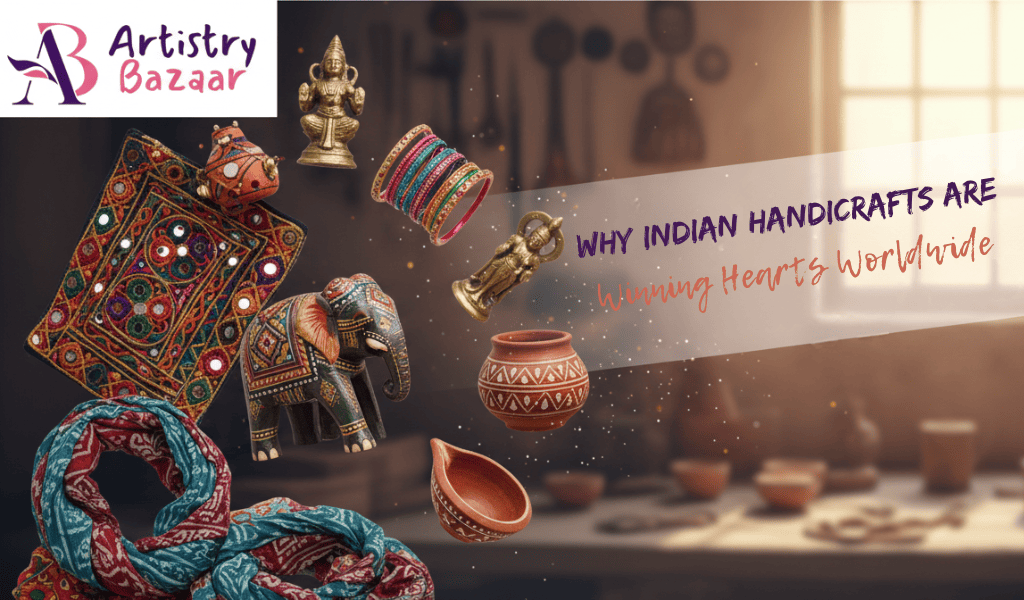Walk into any modern home today in any corner of the world, and chances are you’ll notice one thing: Indian handicrafts. They are no longer just artifacts of the past. They are the essence of contemporary decor. From wooden carvings to hand-stitched textiles, Indian craftsmanship is making waves across continents. What was once considered “traditional” is now celebrated globally. But why are people from Tokyo to Toronto falling in love with these creations? Let’s explore the fascinating journey of Indian handicraft products on the world stage.
Craftsmanship That Tells a Story
At the heart of Indian handicrafts lies storytelling. Every handcrafted item carries the legacy of an artisan, often reflecting centuries-old techniques passed down through generations. Unlike mass-produced products, which can feel sterile, a handcrafted item carries emotion, personality, and history.
Take, for example, a handmade leather journal. Beyond its practical use, it embodies hours of meticulous effort—each stitch a testament to the artisan’s skill, each embossed pattern a reflection of cultural heritage. This human touch transforms everyday items into cherished keepsakes.
People today crave connection, not just objects. Owning Indian handicrafts allows buyers to carry a piece of culture, tradition, and personal story into their homes—an experience mass-produced items simply cannot offer.
Regional Diversity That Inspires Global Taste
India’s handicrafts are as diverse as the country itself. Every state brings its unique aesthetic, materials, and techniques to the table:
- Rajasthan: The land of vibrant colors, block prints, and sparkling mirror work that instantly elevates any space.
- Kerala: Known for delicate wood carving and coir products that blend elegance with utility.
- West Bengal: Home to terracotta, Kantha embroidery, and Dokra metalwork that offer rustic charm with modern appeal.
- Kashmir: Famed for Pashmina shawls and papier-mâché art that exude luxury and finesse.
- Gujarat: Renowned for intricate beadwork, embroidery, and Bandhani textiles that marry culture with creativity.
This regional richness allows global consumers to mix and match styles—creating interiors that are personal, eclectic, and meaningful.
Sustainability as a Global Magnet
The modern consumer is conscious, not just stylish. Sustainability has emerged as a driving factor in buying decisions worldwide. Indian handicrafts are perfectly aligned with this shift. Artisans often work with natural, eco-friendly materials like wood, clay, cotton, and leather.
A carefully crafted handmade wooden furniture piece, for instance, is not only an aesthetic statement but also a sustainable choice. Made from responsibly sourced timber, it avoids the environmental costs of mass production while offering durability and timeless design. This eco-conscious appeal has made Indian handicrafts favorites among buyers seeking responsible luxury.
Personalization: From Objects to Experiences
One of the reasons Indian handicrafts are capturing hearts globally is their inherent flexibility. Unlike industrial goods, handmade items can be customized—colors, patterns, size, and finishes can all be tailored to individual tastes.
For example, an intricately carved wooden side table can be designed to fit a contemporary living room or a traditional study. This element of personalization turns an ordinary object into a unique experience, making each purchase meaningful. Buyers don’t just acquire products; they co-create pieces of art that reflect their personality and lifestyle.
Top Selling Home Decor Items That Tell a Story
The global demand for Indian handicrafts is evident in the rise of top-selling home decor items sourced from India. From carved wooden shelves and brass lamps to hand-painted ceramic pots, these items are defining modern interiors worldwide.
Unlike factory-made decor, each piece carries irregularities and textures that make it authentic and visually captivating. These “flaws” are celebrated as signs of originality and craftsmanship, a stark contrast to uniform, mass-produced items. Indian handicrafts allow homes to become storytelling spaces—where every corner speaks of art, culture, and human creativity.
Modern Design Meets Traditional Techniques
Indian artisans are not just preserving history; they are innovating with it. Traditional motifs, weaving techniques, and carving styles are now being adapted to suit modern aesthetics.
Think of Madhubani art on contemporary wall clocks or block-printed textiles incorporated into minimalist sofas. Even Handmade Leather Journals now feature sleek designs suitable for professional settings without compromising on artisanal charm. This seamless blend of old and new is a key factor driving the global popularity of Indian handicrafts.
Emotional and Cultural Connection
Owning Indian handicrafts is about more than style—it’s about forging an emotional connection. Each handcrafted item carries a human story and a cultural essence. A handcrafted lamp, a handwoven rug, or a carved wooden chair is not just decorative; it evokes nostalgia, appreciation, and admiration for human skill. International buyers often describe these items as “soulful” or “alive,” which mass-produced products cannot replicate. This emotional resonance adds immeasurable value to Indian handicrafts in global markets.
Artisans at the Heart of Global Success
Behind every handicraft is an artisan, often working in small villages or remote towns. By supporting Indian handicrafts, global consumers contribute to livelihoods and help preserve endangered skills. This ethical dimension—buying with purpose—enhances the global appeal of these products.
Initiatives like online marketplaces and international craft fairs have enabled artisans to reach buyers worldwide without intermediaries, giving them fair recognition and income. This connectivity has not only boosted global sales but also ensured that traditional skills continue to thrive.
Technology and the Digital Marketplace
Digital platforms have revolutionized the way Indian handicrafts reach global audiences. Social media, e-commerce websites, and online craft communities have allowed artisans to showcase their work to international buyers directly.
Today, you can purchase authentic Handmade Wooden Furniture, intricate hand-painted decor, or luxurious Handmade Leather Journals from the comfort of your home—bridging the gap between traditional craftsmanship and modern convenience. Technology has transformed these artisanal creations into global treasures, accessible to anyone, anywhere.
Challenges and Opportunities Ahead
Despite their growing popularity, Indian handicrafts face challenges. Competition from cheaper imitations, limited access to raw materials, and marketing hurdles remain real obstacles.
Yet these challenges present opportunities. With growing awareness of ethical consumerism, sustainability, and cultural appreciation, there is a huge potential to position Indian handicrafts as a premium, desirable choice worldwide. Creative marketing, collaborations with international designers, and digital storytelling can elevate these products to new heights.
Closing Remarks
Indian handicrafts are winning hearts not just because they are beautiful, but because they are meaningful. They offer sustainability, personalization, cultural depth, and emotional connection—all qualities the modern global consumer seeks. In a world dominated by mass production and fleeting trends, Indian handicrafts remind us of the value of patience, skill, and storytelling. ArtistryBazaar is a B2B e-distributor platform that offers multi-category handmade products. They connect artisans from rural India with global markets and promote ancestral art. We offer free worldwide shipping, door-to-door delivery, flexible payments (just 30% upfront and 70% before dispatch), and an extra up to 10% off with our promo code.

